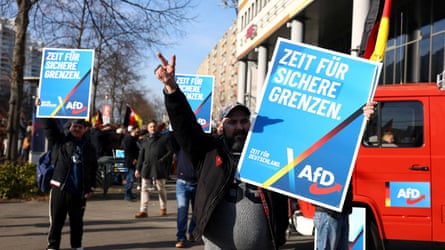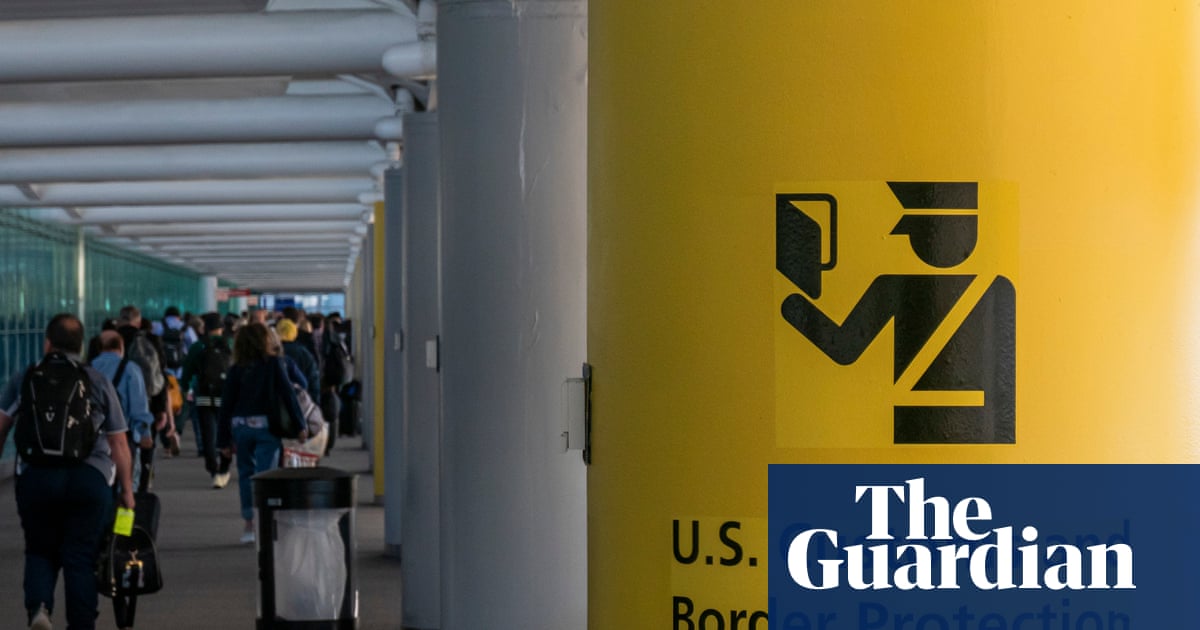Germany’s far-right Alternative für Deutschland (AfD) party has welcomed the US government’s decision to classify a prominent German anti-fascist group and three other European networks as terrorist organisations, calling on Berlin and other European governments to follow the example.
But historians of antifascism warned that at a time when far-right groups were making electoral gains across the continent, the move set a dangerous precedent that could prepare the ground for a broader crackdown on leftwing activism.
The US state department announced on Thursday that the ban would apply to Germany’s Antifa Ost, an anti-fascist group whose members have been prosecuted by German authorities for attacks on far-right figures; Italy’s International Revolutionary Front, which sent explosive packages to the then president of the European Commission in 2003; and two organisations accused of planting bombs in Greece: Armed Proletarian Justice and Revolutionary Class Self Defense.
The AfD has long called for German authorities to make a similar such ruling against antifascist groups, even before it became the largest opposition in the German parliament earlier this year.
“Antifa is a terrorist organisation, and it would be easy for the German state to take action against it, only those in power don’t want to,” said Stephan Brandner, the deputy federal spokesperson for the AfD, accusing the German state of tolerating far-left violence.
The designation could result in the freezing of any assets belonging to the groups held in the US and a ban on their members entering the country.
Mark Bray, a Rutgers University professor who teaches a course on the history of antifascism, said that of the four proscribed groups, only Antifa Ost was an explicitly anti-fascist organisation.
“The others are revolutionary groups,” he said. “This shows how the Trump administration is trying to lump all revolutionary and radical groups together under the label ‘antifa’. By establishing the (alleged) existence of foreign antifa groups, the Trump administration seems to be setting the stage for declaring American antifa groups (and all that they deem to be ‘antifa’) to be affiliated with these supposed foreign terrorist groups.”

The antifa movement emerged in Germany in the 1920s. But the term is an extremely loose one that is frequently applied to a variety of leftwing activist groups, whose common denominator is their opposition to fascism.
Members of Antifa Ost are accused of attacking a neo-Nazi in Dresden as well as other acts of violence against people perceived as belonging to the far-right scene, including in Hungary, between 2018 and 2023.
Six alleged members were charged in July in Germany, and its most prominent member, Maja T, who describes themself as non-binary, is being held in custody in Hungary in conditions they have described as inhumane. They are facing trial in January and have been told they could face up to 23 years in prison.
Germany’s BfV domestic intelligence service, which has designated the AfD as a “confirmed rightwing extremist” force, has previously concluded that the antifa “movement” has neither a fixed organisational structure nor any clearly defined hierarchies.
The historian Richard Rohrmoser said the name was such a broadbrush term it could be applied not just to “black-clad groups ready for violence” but also to peaceful activist groups from the Anne Frank Center to the White Rose student movement, the Christian-inspired student group that opposed the Nazis in the 1930s.
after newsletter promotion
“Trump is pursuing a perfidious tactic,” he told Der Spiegel. “By labelling groups as ‘antifa’, he can ban leftwing groups and demonstrations and crack down on opposition figures as soon as someone is seen wearing an antifa sweatshirt or carrying an antifa flag.” By doing so, he said, he can legitimise any action he takes against “anyone who is, in a broader sense, to his left, or opposed to him”.
Italy’s Fai/Fri, or Informal Anarchist Federation/International Revolutionary Front, is a collection of anarchist-insurrectionist cells considered to be the most structured and well-established of the European groups designated by the Trump administration. The group, which unlike other Italian anarchist movements expresses itself through violence, was founded in December 2003, when it distributed leaflets claiming responsibility for the explosion of two bins close to the home in Bologna of , who at the time was president of the European Commission. A few weeks later, a parcel bomb exploded in Prodi’s hands. He was uninjured.
Italy’s security services describe Fai/Fri as a “horizontal” movement made up of autonomous cells united by an insurrectionist-anarchist ideology and which uses armed direct action. Other actions include letter bomb attacks in 2010 on the Swiss and Chilean embassies in Rome and the 2021 kneecapping of Roberto Adinolfi, the then chief executive of the nuclear engineering company Ansaldo Nucleare.
Mary Bossis, an emiritus professor of international security at the University of Piraeus in Athens, said violence was common on the edges of broad-based social movements. “But that does not mean, as in the case of antifa, that the whole movement is either violent or supportive of terrorism. In fact it is very much not the case … Standing against fascism does not make someone a terrorist.”
Greek media reports described the US move as “a dangerous development” at a time when the threat from the right, on both sides of the Atlantic, was so visibly on the ascendant.
Following the dismantlement of the neo-Nazi Golden Dawn, which rose to be Greece’s third biggest party during its near decade-long debt crisis, ultra-nationalist, far-right parties have emerged and been voted into parliament.

 German (DE)
German (DE)  English (US)
English (US)  Spanish (ES)
Spanish (ES)  French (FR)
French (FR)  Hindi (IN)
Hindi (IN)  Italian (IT)
Italian (IT)  Russian (RU)
Russian (RU)  3 weeks ago
3 weeks ago
























Comments